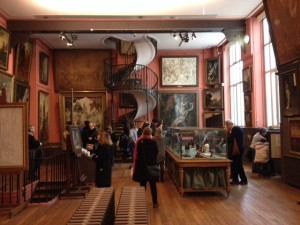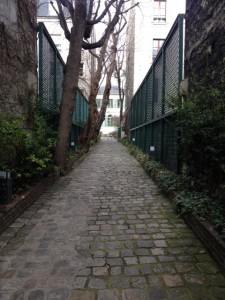Artist House Museums in Paris

There is something quite enchanting about Paris’s smaller museums, and I recently spent a very nice afternoon between two of them in the 9th arrondissement, both housed in what was once an artist’s residence. The different histories of the buildings and their gifting as public spaces, as well as the profiles of the artists and the different collections housed within them, throws into relief the looseness of the concept of an artist’s house museum, and how what may seem to be a very narrow concept can actually be used to impart different messages and create different visitor experiences.
The Musée de la vie romantique, first of all, is in an hôtel particulier, or grand townhouse, set back from the street in peaceful gardens which house a tearoom in the warmer months. It was originally built in 1830, home to the Dutch artist Ary Scheffer, and remained in the hands of the Renan-Scheffer family until it was gifted to the city of Paris in 1983 (having been declined as a gift in the previous century). It houses distinct collections: firstly memorabilia and artworks associated with the writer George Sand on the ground floor, and then works associated with Scheffer and his contemporaries, as well as a display on Ernest Renan, a scholar and writer who married into Scheffer’s family.
As the romantic period is what brings Sand and Scheffer together, it is the theme around which the museum is framed, with a good track record of temporary exhibitions to flesh out what is otherwise a slightly odd mixing of obviously separate collections. Multiple references are made to the soirées which Sand attended at the house, as well as to the contextualised importance of Scheffer as artist and social figure. Really, despite the drawbacks of its tired interior and sleepy volunteers (at least on the day of my visit), I think it is a clever use of collections which, while having intrinsic and educational value, must otherwise have been difficult to house and make use of. The Romantic period is not currently very much in fashion in the wider world of exhibitions and revivals, but this does not mean that there is no public appetite for a small museum which reveals some key personalities and motifs of the era, followed by a spot of tea in an oasis next to the tourist overload that is Montmartre.
Further away from Montmartre, and sitting directly on the street rather than set back in its own quiet garden, is the Musée Gustave Moreau. The museum is this time a national one, and has been more or less unchanged since its opening in 1903, the reason being that Moreau himself took the decision that it was to become a museum of his works and studio, and went so far as to plan it out before his death. The first floor displays many smaller works, while upstairs the rooms of his apartment can be visited (all rather melodramatic and showing an intense relationship with his mother and with his ‘intimate friend’ Adelaide-Alexandrine Dureux. The latter more or less has a shrine within the apartment rooms.
It is the uppermost rooms which are the key focus of the museum, however, and in which I suspect the average visitor spends the most time. This was Moreau’s studio, and is a mightily impressive space, with high ceilings showing his large-scale paintings off to perfection, and a sinuous staircase featuring in many a photograph. It is here that his most impressive, densely symbolic and well-known works are shown, and that it is hung like an old-fashioned museum, with paintings more or less covering the walls, adds to its charm. You can tell I was won over by it.
And yet… As much as I was impressed by the space, collection and time capsule qualities of the Musée Gustave Moreau, I think it was the Musée de la vie romantique which I liked the most. Perhaps it’s that I always like an underdog, but I felt the latter had the romance, if you’ll pardon the term, of a slightly haphazard institution, born of various idiosyncratic gifts to the city, but making the most of them and moulding them into a coherent vision. The nature of Moreau’s house museum, including that it is largely still laid out according to his own vision, is a point of interest but also a limitation, meaning that since its very beginning it has not had to strive for relevance but has been able to rest on its laurels and build its reputation for inspiring the next generation of artists. The Musée de la vie romantique, on the other hand, is more of a self-made man of Parisian artist house museums, bringing in visitors, and repeat visitors too, despite the fact that the only time I had ever heard the name of its key artist was between its walls. If nothing else, Ary Scheffer clearly knew how to pick a good spot for an hôtel particulier.

